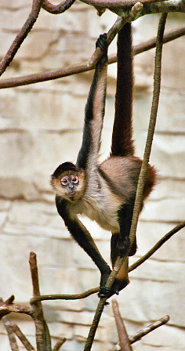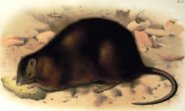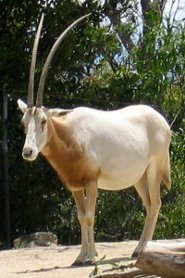Tuesday 27 November 2012
Central American Spider Monkey - A Smart Primate That Barks Like a Dog

The
Central American Spider Monkey (
Ateles geoffroyi), also called Geoffroy's Spider Monkey or the Black-handed Spider Monkey, lives in the canopies of tropical forests throughout Central America, southern Mexico, and the northwest coast of South America. These monkeys are 12-25 inches (30-65cm) tall with a tail 24-33 inches (60-85cm) in length. Weight for a full grown monkey can range from 13-20 lbs. (6-9kg) with males weighing slightly more than females. There are several subspecies of this spider monkey with varying fur colors ranging from blond to dark red, but they all have some black fur.
These monkeys practice "fission-fusion" grouping: At night they gather in groups of twenty to one hundred monkeys which split into groups of two or three during the day to search for food. The only primates that share this trait are chimpanzees and humans.
Central American Spider Monkeys are believed to be the fourth smartest primate behind humans, chimpanzees, and orangutans. They have been seen using tools in two ways: They often rub a mixture of ground lime tree leaves and saliva into their fur which may act as an insect repellent. When frightened the monkeys will break off branches and drop them on the threat. Their primary predators are large cats including
pumas,
jaguars, and
ocelots. Large snakes and birds of prey have also been known to eat spider monkeys on occasion.
Often the monkeys don't have to resort to breaking branches. They warn potential predators by make a loud barking sound like a dog; locals know enough to stay out of a monkey’s way or risk blunt trauma. If a monkey is separated from its group it whinnies like a horse.
Central American Spider Monkeys are an endangered species. Logging has limited their habitat while they have been hunted for food or to be kept as pets. The majority of the monkey's diet is fruit and nuts, although they have been known to eat honey, bark, and insects when their preferred foods are in short supply. Scientists have noticed a decline in the number of spider monkeys in the year following an El Niño. The weather from this phenomenon reduces the amount of food available to the spider monkey and there is some concern that increases in El Niño strength from climate change could have a long term effect on monkey populations. These monkeys can contract malaria, making them a valuable tool for studying the disease but this also means they are susceptible to outbreaks.
Efforts to protect the monkeys have concentrated on restricting logging and mining in their habitat. Spider monkeys will breed in captivity which has prompted zoos to start breeding programs which will increase wild populations.
Picture of the Central American Spider Monkey by Lea Maimone in the Brookfield Zoo - Chicago, IL, licensed under the
Creative Commons Attribution-Share Alike 2.5 Generic license.
You can help spreading the word about this animal by liking it on facebook
Permanent Link
Friday 23 November 2012
The Bulldog rat - The Mysterious, Extinct Creature of the Islands

The
Bulldog rat (
Rattus nativitatis) is an extinct species that once lived in the Indian Ocean area of Christmas Island. When the Bulldog rat was alive and thriving in the area, they were mostly found in the higher hills and forests of the area. They would have lived in smaller colonies in burrows among the roots of trees, or many times their home would be under hollow logs. Since bulldog rats were nocturnal, sunlight may make them seemed half dazed as it would almost blind the creature, which was why they burrowed deep into the ground.
The Bulldog rat was around 17 inches long or about 50 centimeters. The Bulldog rat had about a 2 centimeter thick layer of fat on their back. The weight of the creature is not really known, as they have been extinct for quite some time. However, most people theorize that they are near the size of rats that are found now.
The Bulldog rat is suspected to have become extinct in the time frame of 1901 to 1908. There are debates on the exact date. However, most researchers are in agreement that the extinction of this creature came from a disease that was spread to it by the
black rats. These rats were infected by what the sailors brought with them. All though, it wasn't intentional, it did lead to the death of this species. These rats were first introduced to the island in 1887.
Given that there is such little information on the species, no one really knows the lifestyle of the creature, thus what they would have been known for is still a mystery. The diet of the Bulldog rat would have consisted of whatever it could find in the wilderness. It would be safe to assume that small insects and plants would have been in supply for these creatures. In fact, the island was thought to have been completely absent of life until new data surfaced which shows exactly why there is not an abundance of information to be found on the Bulldog rat.
The little research that is known about animals on this particular island point that there are not that many predators living there. In fact, during their lifespan, there has only been three other species of animals documented to be found there. Therefore, it would seem that predators of the Bulldog rat would be nonexistent.
You can help spreading the word about this animal by liking it on facebook
Permanent Link
Thursday 15 November 2012
Scimitar-Horned Oryx - The Real Unicorn

The
Scimitar-horned oryx (
Oryx dammah) is a species of large antelope in the Oryx genus. Originally inhabiting the steppes and deserts of North Africa, it is currently extinct in the wild. Although there were reported sightings in Chad and Niger, attempts to independently verify these claims in a survey conducted from 2001 to 2004 turned up no trace of them in the wild. Currently, around 1250 live in captivity in fenced-off areas in conservation centers as distant from each other as Texas and Morocco.
The Scimitar-horned Oryx's most notable feature are its long, slender horns, which in both the male and female can reach between one and one and one quarter meters (3.28 - 4.1 ft) in length. The horns are truly distinctive in the way they arch backward like scimitars, the Middle-Eastern curved sword from which they take their name. The average Scimitar Oryx is about a meter (3.28 ft) tall and weighs roughly two hundred kilograms (440 lbs). Its coat is generally light in color with a dark red patch on its chest, and has markings along the its nose and forehead.
The Scimitar-horned oryx's diet consists of grass, leaves, and any other wild vegetation it can find. When hundreds of herds roamed the North African steppes, its main predators were
lions,
leopards, and
hyenas. However, it was human hunters, who sought the oryx for its horns, who drove it to the brink of extinction.
One of the more fascinating things about the Scimitar-horned Oryx is its connection to the mythological unicorn. Because their horns are not like the antlers of other related species in that they do not grow back, many mythographers have hypothesized that members of the species who lost one their horns might have been mistaken for the legendary creatures by early European explorers and colonists in North Africa. What would have added to the impression is the fact that single-horned Scimitar Oryxes are quite often ostracized from their herds, forcing them to wander the steppes alone in order to survive. To Europeans, this perfectly matched the image of the unicorn, which was known for its pride and independent nature.
Even though they are extinct in the wild, there is still hope that it will be able to be reintroduced to the wild at some point. In Tunisia, there is a nature preserve which houses a small herd with precisely this end in mind. Also, as recently as this April, the first calf in 13 years was born at the National Zoo in Fort Royal, Virginia. With luck, within our lifetime, these pro-unicorns may roam the wild again.
Picture of the scimitar-horned oryx by Albinfo, licensed under
GFDL
You can help spreading the word about this animal by liking it on facebook
Permanent Link
 The Central American Spider Monkey (Ateles geoffroyi), also called Geoffroy's Spider Monkey or the Black-handed Spider Monkey, lives in the canopies of tropical forests throughout Central America, southern Mexico, and the northwest coast of South America. These monkeys are 12-25 inches (30-65cm) tall with a tail 24-33 inches (60-85cm) in length. Weight for a full grown monkey can range from 13-20 lbs. (6-9kg) with males weighing slightly more than females. There are several subspecies of this spider monkey with varying fur colors ranging from blond to dark red, but they all have some black fur.
The Central American Spider Monkey (Ateles geoffroyi), also called Geoffroy's Spider Monkey or the Black-handed Spider Monkey, lives in the canopies of tropical forests throughout Central America, southern Mexico, and the northwest coast of South America. These monkeys are 12-25 inches (30-65cm) tall with a tail 24-33 inches (60-85cm) in length. Weight for a full grown monkey can range from 13-20 lbs. (6-9kg) with males weighing slightly more than females. There are several subspecies of this spider monkey with varying fur colors ranging from blond to dark red, but they all have some black fur.
 The
The  The
The